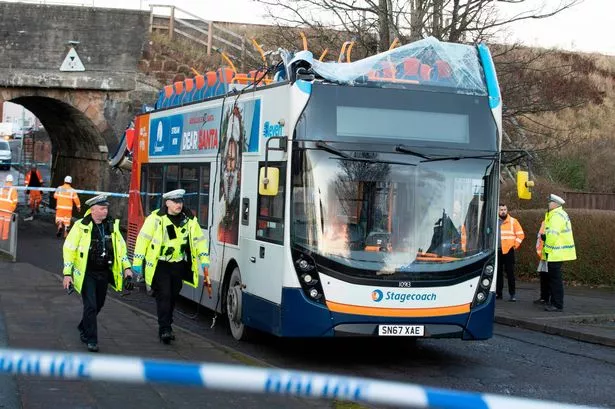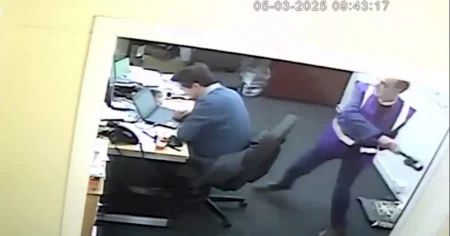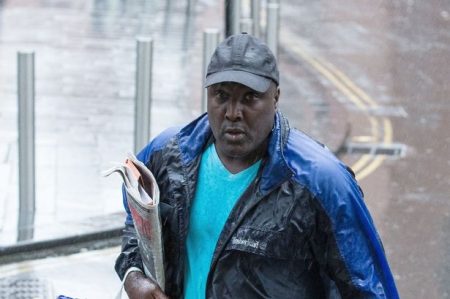The tranquil Friday afternoon in Kilmarnock, Scotland, was shattered by a jarring collision that sent shockwaves through the community. A double-decker bus, operating a regular route, misjudged its clearance and struck a low-lying railway bridge with a sickening crunch of metal and glass. The impact ripped through the upper deck, transforming a mundane commute into a scene of chaos and injury. Eight passengers aboard the bus sustained injuries ranging from minor cuts and bruises to more serious trauma. The incident immediately triggered a large-scale emergency response, drawing police, fire crews, and paramedics to the scene. The bridge itself also suffered structural damage, prompting an immediate closure of the railway line pending a thorough inspection.
The aftermath of the crash resembled a disaster movie set. The mangled remains of the bus’s upper deck lay scattered across the road, a stark testament to the force of the impact. Passengers who escaped with minor injuries recounted harrowing tales of the sudden jolt and the ensuing panic. Some described being thrown from their seats, while others were trapped amidst the debris. The quick response of emergency services proved crucial in mitigating the severity of the incident. Firefighters worked tirelessly to extricate trapped passengers, while paramedics provided immediate medical attention to the injured. A makeshift triage center was established near the crash site, where victims were assessed and stabilized before being transported to local hospitals.
The incident sparked immediate investigations into the cause of the collision. Authorities focused their attention on several key areas, including the driver’s actions, the bus company’s safety protocols, and the signage and infrastructure surrounding the bridge. Preliminary reports suggested that the driver may have deviated from the designated route, potentially due to road closures or a navigational error. The bus company, under intense scrutiny, launched its own internal investigation and pledged full cooperation with the authorities. Investigators also examined the bridge’s warning signage and clearance markings to determine if they were adequate and clearly visible. The investigation aims to pinpoint the contributing factors that led to the crash and prevent similar incidents in the future.
The incident highlighted the inherent risks associated with double-decker buses navigating low-clearance areas. These vehicles, while efficient for transporting large numbers of passengers, pose a unique challenge due to their height. The Kilmarnock crash underscores the critical importance of precise route planning, driver training, and rigorous adherence to safety regulations. Experts emphasized the need for comprehensive risk assessments and regular inspections of routes to identify potential hazards, such as low bridges or overhanging obstacles. Furthermore, the incident renewed calls for advanced driver-assistance systems (ADAS) in buses, such as lane departure warnings and automatic emergency braking, which could potentially prevent similar accidents.
The incident also prompted a broader discussion about the safety of road infrastructure. While the immediate focus was on the driver’s actions, the crash exposed potential vulnerabilities in the design and maintenance of roads and bridges. Critics argued that the bridge’s low clearance, coupled with inadequate warning signage, created a hazardous situation for high-profile vehicles. Calls for improved signage, including more prominent height restriction warnings and clearer route guidance, gained momentum in the wake of the crash. The incident served as a stark reminder of the shared responsibility between transportation authorities, vehicle operators, and drivers in ensuring road safety.
The Kilmarnock bus crash serves as a cautionary tale, highlighting the devastating consequences that can arise from a momentary lapse in judgment or a failure to adhere to safety protocols. The incident underscores the importance of a multi-faceted approach to road safety, encompassing driver training, vehicle maintenance, infrastructure improvements, and robust regulatory oversight. The ongoing investigation promises to shed further light on the specific factors that contributed to the crash, offering valuable lessons for preventing similar tragedies in the future. The incident also serves as a poignant reminder of the human cost of such accidents, impacting not only the injured passengers but also their families, the community, and the emergency responders who witnessed the traumatic aftermath. The road to recovery for those injured, both physically and emotionally, will be long and challenging, underscoring the enduring impact of this unfortunate event.














